ABSTRACT
The studies were concerned in removal of Cu (II) from the synthetic waste water using kaolinite clay-sequencing both batch and fixed bed reactor systems. Batch studies revealed that the initial uptake of copper ion on kaolinite clay was rapid and equilibrium was established about in 1 h. The adsorption isotherm studies clearly indicated that the adsorptive behavior of metal ions on kaolinite clay not only the Langmuir assumptions but also the Freundlich Ion-exchange and surface adsorption might be involved in the adsorption process of copper on kaolinite clay. In fixed bed column modeling, adsorption of copper on kaolinite clay at three different flow rates was investigated. The column having a diameter of 2 cm, with different bed depths such as 10, 20 and 30 cm and Thomas’ kinetic parameters were calculated. The experimental results demonstrated that kaolinite clay can be used as an effective adsorbent for removing Cu2+ from aqueous solutions.
PDF Abstract XML References Citation
How to cite this article
DOI: 10.3923/ijct.2010.88.93
URL: https://scialert.net/abstract/?doi=ijct.2010.88.93
INTRODUCTION
Copper is a widely used material, there are many actual or potential sources of copper pollution. Copper is used in Jewelry, paints, pharmaceutical products, wood preservatives, pigments, metal works, petroleum refinery, motor vehicle and aircraft plating and finishing. Also copper may be found as a contaminant in food, especially shellfish, liver, mushroom, nuts and chocolate. In addition, any processing method or container using copper material may contaminate the product, such as food, water or drink (Wallace et al., 2003). Copper is essential to human life and is required for various biological processes, but like all heavy metals, is potentially toxic as well (Nuhoglu et al., 2002). According to the World Health Organization, the accepted range of Cu+2 in water is 0.01 ppm since, copper ions is non-degradable into nontoxic end products, their concentrations in effluents must therefore be reduced to acceptable levels before discharging them into the environment. There are many conventional processes for the removal of copper from wastewater streams such as precipitation, coagulation, ion exchange etc. (Basci et al., 2004; Kartal et al., 2008; Nasernejad et al., 2004). These processes have many disadvantages such as incomplete removal, high energy and reagents costs and disposal of toxic sludge. Respectively, among the unit operations in water and wastewater treatment, adsorption occupies an important position (Ahsan et al., 2007; Aksu and Isoglu, 2005; Panneerselvam et al., 2009; Zheng et al., 2008). Adsorption methods were found to be more effective and attractive due to its lower costs and the higher efficiency of heavy metal ions removal from wastewater. In this study, the kaolinite clay which was obtained from Fayum city, Egypt will be investigated as a potential and low cost adsorbent for Cu2+ ions from aqueous solutions. The thermodynamic and kinetic parameters involved in the adsorption process will be estimated using the both technique, batch and fixed bed column.
MATERIALS AND METHODS
Kaolinite clay samples were obtained from Al-Fayum governorate were used as adsorbent material. During the period from 1-6-2003 to 1-8-2004. The collected raw samples have been subjected to beneficiation process using hydro cyclone to reduce the quartz ratio as described by Gougazeh (2001). Hence, a high grade kaolinite was implemented for the adsorption experiments. The mineralogical and chemical composition of the clay before and after beneficiation are displayed in Table 1.
Batch Experiments
In this experiments, kaolinite clay, Beneficiated and raw, has been washed at the first step and then rinsed with distilled water. After drying in 100°C, it was ground and screened, using screen with mesh size 10. For preservation, it was kept in plastic-stopper bottle (containers) and to minimize contact with humidity all these bottles were preserved in desiccators before the time of use. Solutions of CuSO4 was prepared for the simulation of a contamination by Cu solutions of Cu with 5 different concentrations of 0.2, 0.3, 0.4, 0.5 and 0.7 mg L-1 where, prepared synthetically and in order to determine the efficiency of kaolinite clay in metal adsorption. Also, Batch tests were applied using 5 different amounts of adsorbent: 0.2, 0.5, 0.7, 1.0 and 1.5 g in single solution for the both adsorbents, Beneficiated and raw kaolinite clay.
The procedure for first batch experiment was as follows: to 25 flasks each containing different grams adsorbent, with known concentration of copper were added. All flasks were then located on a shaker with 300 rpm. After 1 h contact time, the contents of flasks were filtered through Whitman No. 42 filter paper to prevent the probable interference of turbidity. The copper concentration of filtered solutions was then determined using atomic adsorption spectrophotometery. The results from the batch experiment were interpolated with Langmuir and Freundlich curves (Fig. 1, 2).
The langmuir equation is given by Eq. 1 (Chiron et al., 2003):
| (1) |
where, qe is the equilibrium copper concentration on adsorbent (mg g-1), qm the maximum amount of adsorption (mg g-1), K the affinity constant and Ce is the solution concentration at equilibrium (mg L-1). From a plot of (Ce/qe) versus (Ce), qm and K can be determined from its slope and intercept. Also, Freundlich equation was also applied according to Eq. 2 (Stumm and Morgan, 1996).
| (2) |
where, KF represents a Freundlich constant and n stands for a degree of non-linearity.
| Table 1: | Mineralogical composition (XRD, Qualitative) ordered from the higher ratio, given the number 1, to lower ratio, given the number 7 |
 | |
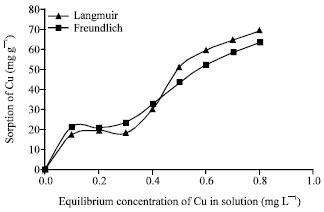 | |
| Fig. 1: | Isotherm for sorption of Cu onto beneficiated kaolinite clay |
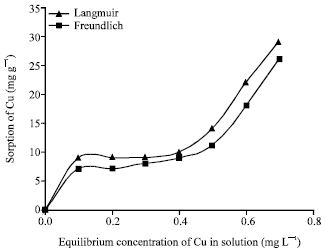 | |
| Fig. 2: | Isotherm for sorption of Cu onto raw kaolinite clay |
Fixed Bed Column Studies
Fixed bed column Thomas model (Thomas, 1944) was used to calculate of column parameter (Eq. 3):
| (3) |
Where:
| Co | = | Inlet Cu concentration (mg L-1) |
| Ct | = | Outlet Cu concentration (mg L-1) |
| Veff | = | Effluent volume at a given flow rate |
| kTh | = | Thomas rate constant (mL/min/mg) |
| qo | = | Equilibrium heavy metal uptake g-1 of the adsorbent (mg g-1) |
| Q | = | Volumetric flow rate (mL min-1) |
| M | = | Amount of adsorbent in the column (g) |
RESULTS AND DISCUSSION
The adsorption of Cu decreased when Cu concentrations increased in the contact solution. Whereas, these results were contradicted with Panneerselvam et al. (2009), Zheng et al. (2008).
| Table 2: | Chemical composition (XRF) |
 | |
| Table 3: | The uptake percent of copper metal onto raw and beneficiated |
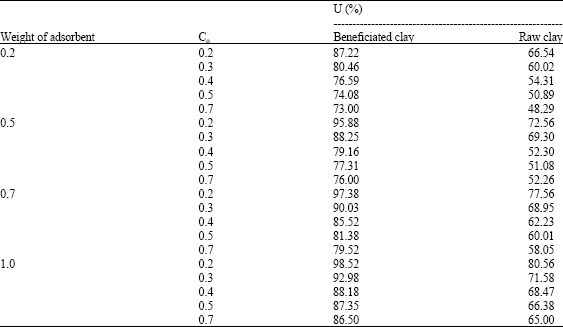 | |
Maximum adsorption uptake of Cu of 96% was seen on 1.0 g beneficiated kaolinite clay. The maximum adsorption of Cu in the Beneficiated kaolinite clay might be due to highest contents of Al2O3 (53.336 %) as seen in Table 2. Also organic- OH (11.015%) are important sites for the absorption of added Cu as a result of complexation of Cu by OH ions and a higher net negative charge. Also, the clays have high sorption sites that allow the non exchangeable (specific) sorption of Cu.
Batch Tests-Sorption Isotherms
Results of the interpolation for Cu static sorption are presented in Fig. 1 and Table 3. Figure 1 shows the highest sorption capacity of beneficiated kaolinite clay for Cu (76 mg g-1). The lowest sorption capacity for Cu was detected on the raw kaolinite clay that contain mainly talc clay. Also, has a high ratio of quartz, which is not favorable for adsorption of heavy metals due to the absence of functional groups such as -OH and -COOH. Moreover, the second contents of the raw kaolinite clay talc clay which is carbonate-free and possesses a low content of organic matter. Table 1 shows the equilibrium concentration of Cu (II) in solution and the adsorption efficiency for various copper concentrations after 1 h. The adsorption rate is dependant on adsorbent amount and initial concentration of metal in synthetic solutions. Increases in adsorption by decreasing the amount of adsorbent seem to be an effect of increase in adsorption sites. Thereby it is passable to have increased adsorption by grinding the adsorbent. For example, 95.88% removal of copper from a 0.2 mg L-1 solution was possible by applying 0.5 g kaolinite clay whereas the similar amount of adsorbent was not enough to treat a 0.7 mg L-1 copper solution to more than about 76%. But by increasing the amount of kaolinite clay to 1.0 g it was possible to increase the efficiency of adsorption to about 86.5% for the same solution (0.7 mg L-1 Cu). So we would have better treatment by using excess kaolinite clay.The experimental data for the adsorption of Cu (II) from aqueous solution onto the beneficiated kaolinite clay were fitted to the Langmuir and Freundlich equations most commonly used. It is determined that the Cu (II) adsorption onto the beneficiated kaolinite clay fits well both Freundlich and Langmuir isotherms. These isotherms obtained at 25°C are shown in Fig. 1 and 2. Figure 1 and 2 indicate that complete saturation of Cu (II) ions on the beneficiated kaolinite clay’s surface is not attained. Furthermore, the fact that adsorption is consistent with the Freundlich and Langmuir isotherms confirms a beneficiated kaolinite clay copper complexation and cation exchange mechanism, respectively.
The Steady State in Columns
The kinetic coefficient kTh and the adsorption capacity of the column qo can be determined from a plot of ln ((Co/Ct)-1) against effluent volume (Veff) at a given flow rate as shown in Fig. 4. Increasing the bed depth caused more metal ions contacted with kaolinite clay at the same time according to lower bed depth, so the adsorption capacity reached the equilibrium value faster as seen in Table 4.
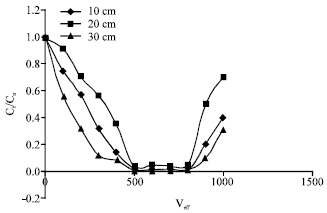 | |
| Fig. 3: | Breakthrough model plots of Cu (II) adsorption on the kaolinite at different bed depth |
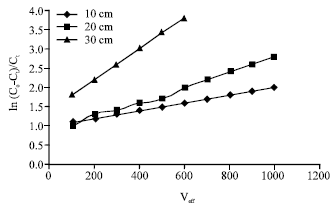 | |
| Fig. 4: | Thomas model plots of Cu (II) adsorption on the kaolinite at different bed depth |
| Table 4: | Thomas kinetic parameters of Cu (II) adsorption at different bed depth |
 | |
Also metal ions had more time to contact with kaolinite for higher bed depth and therefore removal efficiency was higher. However for low bed depth adsorption capacity was high because of the lower amount of kaolinite. In Fig. 3, breakthrough curves are presented for Cu (II) ions, It can be seen that at lower bed depth, a steeper breakthrough curve is obtained and the breakthrough point is moved towards left on the Ct/Co vs. effluent volume (Veff) at a given flow rate. (adsorbent mass: 46 g for 20 cm bed depth and 20 g for 10 cm bed depth) initial concentration: 35 mg L-1 and column diameter: 1.5 cm.
REFERENCES
- Ahsan, H., N. Islam, I. Anarul and A.M. Shafiqul-Alam, 2007. Removal of copper from aqueous solution using orange peel, sawdust and bagasse. Pak. J. Anal. Environ. Chem., 8: 21-25.
Direct Link - Wallace, M.A., S.L. Adverval, C.A. Henriques and A.C.A. Costa, 2003. An evaluation of copper biosorption by a brown seaweed optimized conditions. Electronic J. Biotechnol., 6: 1-8.
Direct Link - Basci, N., E. Kocadagistan and B. Kocadagistan, 2004. Biosorption of copper (II) from aqueous solutions by wheat shell. Desalination, 164: 135-140.
CrossRefDirect Link - Chiron, N., R. Guilet and E. Deydier, 2003. Adsorption of Cu(II) and Pb(II) onto a grafted silica: Isotherms and kinetic models. Water Res., 37: 3079-3086.
PubMedDirect Link - Kartal, S.N., C. Kose, B. Tarakanadha and Y. Imamura, 2008. Adsorption of copper, chromium and arsenic from chromated copper arsenate (CCA) treated wood onto various adsorbents. Open Waste Manage. J., 1: 11-17.
CrossRefDirect Link - Nuhoglu, Y., E. Malkoc, A. Gurses and N. Canpolat, 2002. The removal of Cu(II) from aqueous solution by Ulothrix zonata. Bioresour. Technol., 85: 331-333.
PubMedDirect Link - Panneerselvam, P., V.S.S. Bala, K.V. Thiruvengadaravi, J. Nandagopa, M. Palanichamy and S. Sivanesan, 2009. The removal of copper ions from aqueous solution using phosphoric acid modified β-zeolites. Indian J. Sci. Technol., 2: 63-66.
Direct Link - Thomas, H.C., 1944. Heterogeneous ion exchange in a flowing system. J. Am. Chem. Soc., 66: 1664-1666.
CrossRefDirect Link - Zheng, W., L. Xm, F. Wang, Q. Yang, P. Deng and G.M. Zeng, 2008. Adsorption removal of cadmium and copper from aqueous solution by areca a food waste. J. Hazardous Mater., 15: 490-495.
PubMedDirect Link








